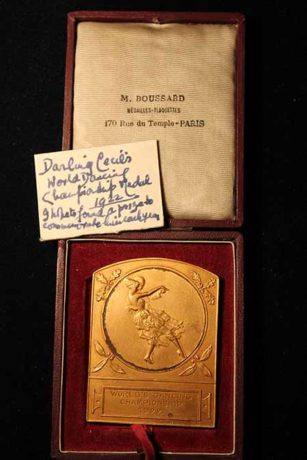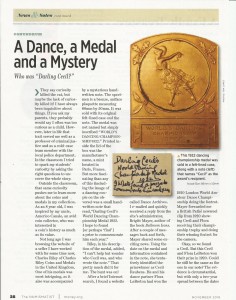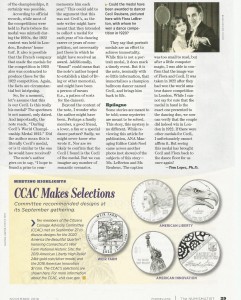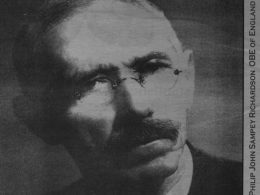Well, that was fun; Tom contacted me asking whether I had any information about the medal and the note in the picture below. I dug into my research for Ballroomicons and was able to help identifying Cecil. Here Toms article as published in ‘The Numismatist’ Issue of November 2018
A Dance, A Medal and a Mystery Text
They say curiosity killed the cat, but maybe the lack of curiosity killed it! I have always been inquisitive about things. If you ask my parents, they probably would say I often was too curious as a child. However, later in life that trait served me well as a professor of criminal justice and as a cold-case team member with the local police department. In the classroom I tried to spark my students’ curiosity by asking the right questions to uncover the whole story.
Outside the classroom, that same curiosity pushes me to learn more about the coins and medals in my collection. As an 8 year old, I was inspired by my uncle, Americo Canale, an avid coin collector, who was interested in a coin’s history as much as its value.
Not long ago I was browsing the website of a seller I have worked with for some time now, Charles Riley of Charles Riley Coins and Medals in the United Kingdom. One of his medals was most intriguing, as it also was accompanied by a mysterious handwritten note. The specimen is a bronze, uniface plaquette measuring 66mm by 50mm. It was sold with its original felt-lined case and the note. The medal was not named but simply inscribed “World’s Dancing/Championship/1922.” Printed inside the lid of the box was the manufacturer’s name, a mint located in Paris, France. But more fascinating than any of this (including the image of a dancing couple on the obverse) was a small handwritten note that read, “Darling Cecil’s World Dancing Championship Medal 1922. I hope to found [or perhaps ‘find’] a prize to commemorate him each year.”
Riley, in his description of the medal, added, “I can’t help but wonder who Cecil was, and who wrote the note.” That pretty much did it for me. The hunt was on! After a brief Internet search, I found a website called Dance Archives. I e-mailed and quickly received a reply from the site’s administrator, Brigitt Mayer, author of the book Ballroom Icons. After a couple of messages back and forth, Mayer shared some exciting news. Using the date on the medal and information contained in the note, she tentatively identified the prizewinner as Cecil Reubens. He and his dance partner Flora LeBreton had won the 1920 London World Amateur Dance Championship doing the foxtrot.
Mayer forwarded me a British Pathé newsreel clip from 1920 showing Cecil and Flora receiving their championship trophy and doing their winning foxtrot for the camera.
Okay, so we found a Cecil. But this Cecil and Flora LeBreton won their prize in 1920. Could he still be the same as the one in our note? The evidence is circumstantial, but with only a two-year spread between the dates of the championships, it certainly was possible. According to official records, while most of the competitions were held in Paris (where the medal was minted) during the 1920s, the 1922 contest was held in London, Reubens’ home turf. It also is possible that the French company that made the medals for the competition in 1920 also was contracted to produce those for the 1922 competition. Again, the facts are circumstantial but intriguing. So, for a moment, let’s assume that this is our Cecil. Is this really his medal? The specimen is not named, only dated. And importantly, the note reads, “Darling Cecil’s World Championship Medal 1922.” Did the author mean this is literally Cecil’s medal, or is it similar to the one he would have received?

The note’s author goes on to say, “I hope to found a prize to commemorate him each year.” This could add to the argument that this was not Cecil’s, as the note writer might have meant that they intended to collect a medal for each year of his dancing career or years of competition, not necessarily just those in which he might have received an award. Additionally, “found” could mean that the note’s author hoped to establish a kind of living or other memorial, and might have been a person of means (i.e., a patron of sorts for the dancer).
Beyond the content of the note, I wonder who the author might have been. Perhaps a family member, a good friend, a lover, a fan or a special dance partner? Sadly, we might never know who wrote it. Nor are we likely to confirm that the Cecil I found is the Cecil of the medal. But we can imagine any number of romantic scenarios.
They say that portrait medals are an effort to achieve immortality. While this is not a portrait medal, it does mark a timely event. But it is the note, ironically with so little information, that immortalizes a champion ballroom dancer named Cecil, and brings him back to life.
Epilogue
Some stories are meant to be told; some mysteries are meant to be solved. This story, this mystery is no different. While reviewing this article for publication, ANA Managing Editor Caleb Noel came across another photo (not shown) of the subjects of this story—Ms. LeBreton and Mr. Reubens. The caption was too small to read, but after a little computer magic, I was able to confirm that the image was of Flora and Cecil. It was taken in 1922 after they had won the world amateur dance competition in London. While I cannot say for sure that the medal in hand is the exact one presented to the dancing duo, we now can verify that the couple did indeed win in London in 1922. If there were other medals for Cecil, I unfortunately cannot affirm it. But seeing this medal has brought Cecil and Flora back to the dance floor for us once again!—Tom Lopez, Ph.D.
Reproduction with permission of ‘The Numismatist’, official publication of the American Numismatic Association money.org












